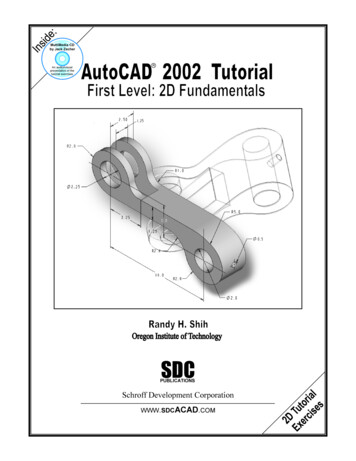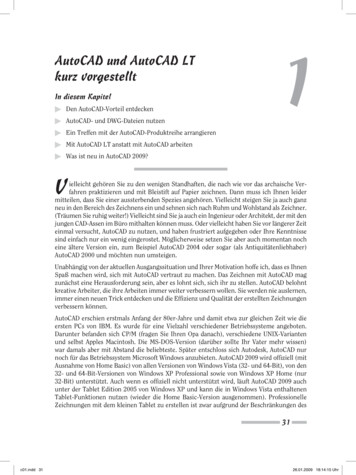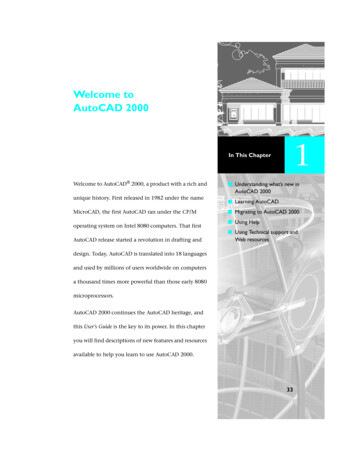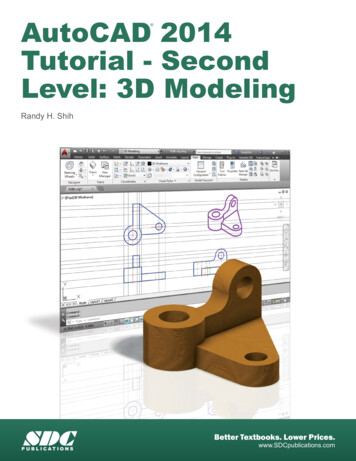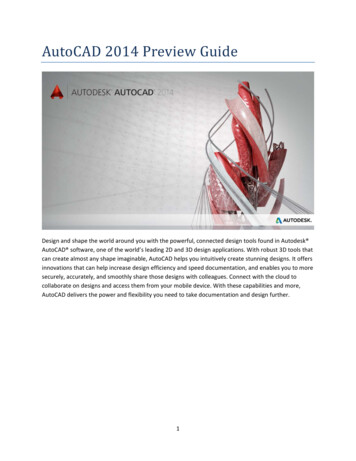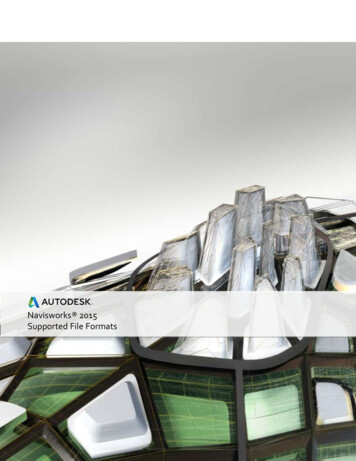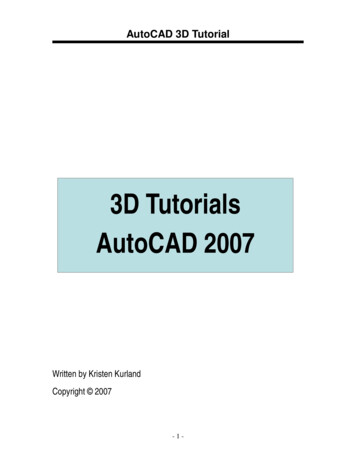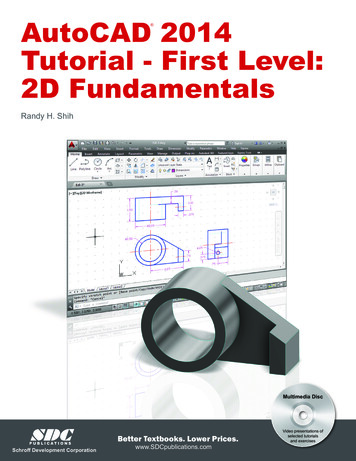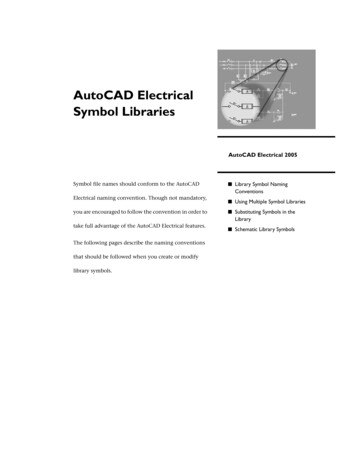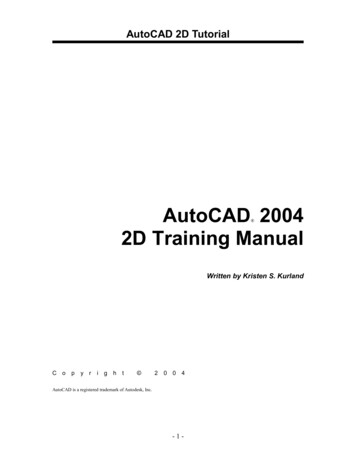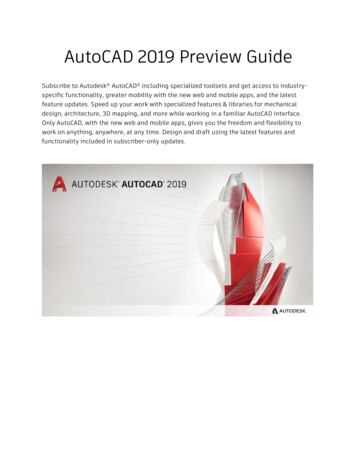
Transcription
AutoCAD 2019 Preview GuideSubscribe to Autodesk AutoCAD including specialized toolsets and get access to industryspecific functionality, greater mobility with the new web and mobile apps, and the latestfeature updates. Speed up your work with specialized features & libraries for mechanicaldesign, architecture, 3D mapping, and more while working in a familiar AutoCAD interface.Only AutoCAD, with the new web and mobile apps, gives you the freedom and flexibility towork on anything, anywhere, at any time. Design and draft using the latest features andfunctionality included in subscriber-only updates.
ContentsSpecialized Toolsets . 3Architecture Toolset . 3Mechanical Toolset . 3Electrical Toolset . 3MEP Toolset . 3Plant 3D Toolset . 3Map 3D Toolset . 3Raster Design Toolset . 4Installing Toolsets . 4AutoCAD Anywhere . 5AutoCAD Web App. 5AutoCAD Mobile App . 6Save to Web and Mobile . 9New Features & Enhancements . 9DWG Compare . 10Shared Views . 15Views and Viewports* . 21Layer Property Overrides* . 25Performance Enhancements . 29High-Resolution (4K) Monitor Support* . 31Standards Checking * . 32Object Selection* . 32*Functionality first made available to AutoCAD subscribers via the AutoCAD 2018.1 Update.2
Specialized ToolsetsOur specialized toolsets for architecture, mechanical design, 3D mapping, and more are nowavailable when you subscribe to AutoCAD 2019.Speed up your work with specialized functionality & libraries. Beyond the core AutoCAD 2019features, each toolset gives you industry-specific capabilities to: Automate the creation of annotations, layers and properties Easily create details and views from 3D models, and simply generate schedules, listsand tables Create rules-driven workflows to enforce standards throughout the design process Track updates of associated views, tables, and other content as designs changeWhen you subscribe to AutoCAD 2019, you will gain access to the following toolsets:Architecture ToolsetUse specialized building design features and 8,000 intelligent architectural objects andstyles to speed architectural drawing and documentation. Automate floorplans, sections,elevations, and other drawings with our architectural toolset.Mechanical ToolsetUse specialized mechanical design features and 700,000 intelligent manufacturing parts,features and symbols to speed product design. Automate tasks, such as generating machinecomponents and creating bills of material.Electrical ToolsetUse specialized electrical design features and 65,000 intelligent electrical symbols to boostproductivity for creating, modifying, and documenting electrical controls systems. Quicklydesign panel layouts, schematic diagrams, and other drawings with our electrical toolset.MEP ToolsetUse specialized MEP engineering features and 10,500 intelligent mechanical, electrical, andplumbing objects to draft, design, and document building systems. Easily design ductwork,electrical conduit, and circuiting for HVAC, plumbing, and electrical with our MEP toolset.Plant 3D ToolsetUse the specialized plant design and engineering toolset to efficiently produce P&IDs andthen integrate them into a 3D plant design model. Quickly create schematic diagrams, plantlayouts, and other drawings with our 3D plant toolset.Map 3D ToolsetIncorporate GIS and CAD data to support planning, design, and data management. Accessspatial data stored in files, databases and web services, and aggregate it with your AutoCADdesign data. Easily manage your GIS data with standard data schema, automated business*Functionality first made available to AutoCAD subscribers via the AutoCAD 2018.1 Update.3
workflows, and report templates for Electric North America, Electric Europe, Water,Wastewater, and Gas industries in our 3D mapping toolset.Raster Design ToolsetUse raster to vector tools to help you edit scanned drawings and convert raster images intoDWG objects. Quickly edit, cleanup and transform images, manipulate raster entities (images,lines, arcs, and circles), create vector shapes (lines and polylines), and more with our rasterdesign toolset.Installing ToolsetsTo take advantage of the industry-specific features and functionality include in the toolsets,you must download each of the toolsets individually. You can do this in two ways — theAutodesk Account, and Autodesk desktop app.The Autodesk Account portal is ideal for administrators who need to download completesoftware packages to create deployments. Alternately, the Autodesk desktop app is the idealway to access products, toolsets and updates right on your desktop.Autodesk AccountGo to accounts.autodesk.com to sign in. From there you will be able to pick and choose todownload AutoCAD or any of the specialized toolsets. For more information about gettingstarted with Autodesk Account, please see the Get Started guide within the AutodeskKnowledge network.Autodesk desktop appYou can also install the specialized toolsets from the Autodesk desktop app. When a toolsetbecomes available, the app displays a notification on the system tray. Open the app andclick My Products and Tools to see all of the toolsets included with your subscription that areavailable to install, then click any of the toolsets to install them individually.*Functionality first made available to AutoCAD subscribers via the AutoCAD 2018.1 Update.4
AutoCAD AnywhereWhen you subscribe to AutoCAD 2019, you gain access to the new AutoCAD web and mobileapps. These apps provide fast, seamless access to DWG files wherever you are, from virtuallyany device. Files load quickly, and you can draft, edit, measure, and annotate with the coretools and technology of original AutoCAD. These powerful features make it possible tocontinue your CAD work with the most up-to-date files while on-the-go.AutoCAD Web AppThe new AutoCAD web app is included when you subscribe to AutoCAD 2019 includingspecialized toolsets.For the first time, you can access original AutoCAD directly in your web browser. With theAutoCAD web app, edit, create, and view your CAD drawings in a simplified web interface fromany laptop. There’s nothing to download — just type in web.autocad.com and login with yourAutodesk account.Some of the key features are highlighted below:DWG File AccessGet quick access to your rich DWG files—not just flat PDFs—from the cloud. Once you uploadany DWG to web and mobile, the DWG can be easily accessed in the browser with the web app.This lets you access your drawings to make quick edits or present projects to clients on anylaptop.Core 2D Drafting and Editing ToolsThe commands in the AutoCAD web app use the same technology as AutoCAD, so you can getstarted right away using familiar, powerful tools. You get core 2D drafting and editingcommands so you can work on drawings even when you’re away from your desktop. Use thesecommands, such as Polyline, Arc, Revcloud, Offset, Trim, Dimension, and more, and check backfor new tools often.*Functionality first made available to AutoCAD subscribers via the AutoCAD 2018.1 Update.5
Original AutoCAD TechnologyA DWG in the AutoCAD web app has same authenticity and precision as it does in AutoCAD. Inthe AutoCAD web app, you can view layouts, access basic object properties, and managelayers, units, and Osnaps. The AutoCAD web app also supports xrefs, so if you upload adrawing with xrefs in it, you can see those xrefs in the drawing. And what you see in thedrawing area—graphics, lineweights, and colors—are what you expect to see when you’re usingdesktop AutoCAD.AutoCAD Mobile AppThe AutoCAD mobile app is included when you subscribe to AutoCAD 2019 includingspecialized toolsets.With the AutoCAD mobile app, you can view, edit, create, and share CAD drawings anytime,anywhere. Available across Windows, Android and iOS phones and tablets, the AutoCADmobile app is also optimized for the iPhone X, iPad Pro and Windows Surface ensuring thebest mobile experience.*Functionality first made available to AutoCAD subscribers via the AutoCAD 2018.1 Update.6
Designed specifically for users working onsite, our mobile app has adapted many of thetraditional desktop AutoCAD tools, and developed new mobile-only tools to extend the powerof AutoCAD to mobile. Some of the key features are highlighted below:DWG File Access—Even OfflineGet full access to your rich DWG files—not just flat PDFs—from the cloud. Access your DWGssaved to your Autodesk account, any cloud storage service (ex: Dropbox, Box, or GoogleDrive), even from email and messaging applications. Your DWGs can also be downloadedlocally on your device so you can work offline without internet connectivity. This eliminatesthe need to carry heavy blueprints in the field, and lets you easily make edits on-the-go, orpresent projects to clients.Magnifier and Object SnapMake accurate edits and measurements with Magnifier and Object Snap. While your finger orApple Pencil is touching the screen, a magnification window appears to show you a zoomed-inview of where you are pressing. The magnifier window appears in the corner of the screen sothe view is not obstructed by your finger. For additional precision, objects snap to a grid inthe mobile app. While drafting or editing this makes it easy align or join objects, createangles, and take measurements.Quick Trim and MeasureMake quick edits and measurements with Quick Trim and Quick Measure, respectively. With asingle tap on the screen, quickly take the measurements of an entire space. Quick Measureautomatically finds the boundaries of a space and displays the distance between thoseboundaries.*Functionality first made available to AutoCAD subscribers via the AutoCAD 2018.1 Update.7
Laser MeasurementsAdd laser measurements directly to your drawings by connecting the Leica DISTO to yourmobile device via Bluetooth. It makes taking real-world and as-built measurements incrediblyeasy. The drawing is updated in real-time as you take a measurement with the Leica DISTO.Annotations and Photo AttachmentsLog quick observations from the field using annotation tools like shapes, arrows, text,highlights, even photos directly on your drawings. For greater onsite clarity of progress andissues, take a photo from your device’s camera, or add a photo from your camera roll.Mobile Device OptimizationsThe AutoCAD mobile app is available on a wide breadth of mobile devices, and takesadvantage of the latest mobile technologies. On devices like iPad Pro and Windows Surface,the mobile app takes advantage of the high-resolution display to ensure drawings are easy toread and work with, and supports the stylus for more precise drafting, editing, andannotations. It even supports external keyboards like on the Windows Surface. As new mobile*Functionality first made available to AutoCAD subscribers via the AutoCAD 2018.1 Update.8
devices evolve, we continue to push the boundaries of what you can do on the AutoCADmobile app.Save to Web and MobileTo make the most of AutoCAD on web and mobile, AutoCAD 2019 includes new “Save To Web &Mobile” and “Open From Web & Mobile” capabilities. Together, these commands enable you tomove files between your desktop, and web and mobile so you can work anywhere.For example, you can take a drawing you were working on at your office, view and edit it in thefield on the AutoCAD web or mobile app, and save it back to your local network drive tocontinue working at your office.Specifically, “Save To Web & Mobile” lets you save your drawings from your desktop to beedited, viewed, or shared on mobile apps and the web. When you save with this option, adialog box will open and you can select where to place your files. Now that file is available inAutoCAD on web or mobile.Conversely, “Open From Web & Mobile” lets you access the latest drawings created or editedon the AutoCAD web or mobile app. When you open a file with this option, this drawing isstored in the cloud and not on your local computer. To bring the drawing to your local storage,you will need to Save As a new version or replace the old version on your local network.These commands can be accessed from the App Menu as options within Open & Save, or theQuick Access Toolbar. The first time you use these commands, you will have to install our“Save to Web & Mobile” extension. Once the extension is loaded, you’re all set.New Features & EnhancementsThis year we have made a number of updates to AutoCAD. The new features andenhancements below are available in AutoCAD.Refreshed IconsAs part of our continuous efforts to provide a great visual experience to our customers,AutoCAD 2019 has new ‘flat designed’ icons in the Ribbon, Status Bar, Quick Access Toolbar*Functionality first made available to AutoCAD subscribers via the AutoCAD 2018.1 Update.9
(QAT) and Application Menu. The flat designed icons provide a better visual experience whenusing AutoCAD, especially on a high-resolution monitor. AutoCAD 2019 also dynamicallymatches icon sizes to your monitor resolution or pixel density.DWG CompareNew DWG Compare tools in AutoCAD 2019 enable you to easily identify graphical differencesbetween two revisions of any drawing. This new functionality is particularly helpful for quicklyviewing changes, identifying clashes, reviewing constructability, and more. For example,consider these two versions of a floor plan. What is different between them? The change issmall, but critical.With the DWG Compare functionality, this is what you can see:*Functionality first made available to AutoCAD subscribers via the AutoCAD 2018.1 Update.10
The green and red graphics highlight the differences between the first version of the drawing(green) and the second version (red). All unchanged elements are shown in grey. Havingdisplayed this important difference, now you can adjust the positions of the cubicles adjacentto this exit stair to maintain the required clearance.Starting a DWG ComparisonDWG Compare can be accessed from AutoCAD’s Application menu, the Collaborate Tab on theribbon, or directly from the command line (“COMPARE”). It’s available in the main Applicationmenu when no drawing is active or under Drawing Utilities when there is a drawing active.You can also access it from the new Collaborate ribbon tab.*Functionality first made available to AutoCAD subscribers via the AutoCAD 2018.1 Update.11
If the current drawing has been saved, it is used as DWG1 in the DWG Compare dialog box.The dropdown list provides easy access to currently and recently opened drawings. You canalso use the browse buttons [ ] to select a drawing from the file navigation dialog.Viewing ResultsThe results of the comparison are displayed in a third drawing. Three categories of objects, orparts of objects, are displayed – those which are located only in the first drawing, those whichare located only in the second drawing, and those which are identical in the two drawings.The default name of the new drawing is “Compare DrawingOne vs DrawingTwo” (where theseare the names of the two drawings being compared), but you can change it, if and when yousave the comparison result drawing.A contextual Compare ribbon tab lets you to control the appearance of results.This tab has three groups of controls–Comparison, Compare Filter and Change Set.*Functionality first made available to AutoCAD subscribers via the AutoCAD 2018.1 Update.12
ComparisonTo show or hide any of the three categories of comparison graphics, click the lightbulb icon infront of the appropriate category.To change the color of one of the categories, click on the adjacent color tool. This will allowyou to select any color for that category.To change which drawing is displayed in front, click “Draw Order.”When you click the folder icon, the drawing will be opened (if it is found with the same name,in the original folder path) or it will be set as the current drawing if it is already open.Click “Drawing Information” to display a dialog that contains the identity of the two drawingsbeing compared. From this dialog, you can add a table to the compare result drawing withthis information, or copy the text to the clipboard for use in other documents. The identity ofthese drawings (folder path, date saved and saved by) is preserved with the result drawing.Compare FilterTo include text in or exclude text from the comparison result, click the Text button. Thiscovers all text, such as block attributes and dimension text.To include or exclude hatch in the comparison result, click the Hatch button. The boundary ofthe hatch (if any) will still appear and will be compared.The settings for these two filters are saved with the drawing, but the default is to have Textincluded, and Hatch not included.Change SetThe first button controls whether the automatic Revision Clouds are displayed or not. Evenwhen they are turned off, the change sets remain.The bottom line of the tools contains the number of the current change set, and the totalnumber of change sets, based on the other controls. Use the left and right arrow buttons tozoom from one group of differences to another.*Functionality first made available to AutoCAD subscribers via the AutoCAD 2018.1 Update.13
Adjust “Margin” to determine how Revision Clouds (change sets) combine with one another.This represents extra space around the bounding box of the individual difference graphics.When individual differences plus the margin overlap, they will be merged into a single changeset. Dragging the slider to the left will separate changed entities from each other, resulting inmore total change sets. Dragging the slider to the right will merge them together, resulting infewer total change sets.The Revision Cloud Shape controls whether the merging of individual changes results in asingle larger rectangle, or whether the individual rectangles of each change are merged into apolygonal shape.RectangularPolygonalThis setting defaults to Rectangular, but is saved with the comparison result drawing.Commands and System VariablesTo support the powerful new DWG Compare functionality in AutoCAD 2019, the following newcommands and system variables have been added:Command NameMeaningCOMPARE or -COMPAREBegin the calculation of differences between two drawingsCOMPAREINFODisplay the dialog with information about the two source drawingsSysvar NameMeaningValueCOMPARECOLOR1Color of the objects that are unique toDWG1String, depending oncolor setting – Index,True Color or Color BookCOMPARECOLOR2Color of the objects that are unique toDWG2String, depending oncolor setting – Index,*Functionality first made available to AutoCAD subscribers via the AutoCAD 2018.1 Update.14
True Color or Color BookCOMPARECOLORCOMMONColor of the objects that are common toboth drawingsString, depending oncolor setting – Index,True Color or Color BookCOMPAREFRONTThe number of the drawing that is drawnin frontInteger (1 or 2)COMPAREPROPSIf zero, objects are not marked asdifferent when properties are different.If non-zero, property changes will bemarked as differences, according to thebit codesInteger (0 to 127)1 color2 layer4 linetype8 linetype scale16 lineweight32 thickness64 transparencyCOMPARESHOWCOMMONShow/hide objects that are common toboth drawingsON/OFFCOMPARESHOW1Show/hide objects that are unique toDWG1ON/OFFCOMPARESHOW2Show/hide objects that are unique toDWG2ON/OFFCOMPAREHATCHShow/hide hatch in the comparisonresult drawingON/OFFCOMPARETEXTShow/hide text in the comparison resultdrawingON/OFFCOMPARETOLERANCEThe decimal point below which entitiesare considered identicalInteger (0 to 14)COMPAREMARGINThe margin between the bounding box ofdifferences and the boundary of thechange group, from very tight to veryloose.Integer (1 25)COMPARERCSHAPEShape of the automatically generatedrevision cloudsInteger(0/1)0 Rectangular1 PolygonalCOMPARESHOWRCShow/hide the automatic revision cloudsON/OFFShared ViewsThe Shared Views feature makes it easier for you to share your designs with stakeholderswithin or outside your company without releasing your original drawing files. This feature is*Functionality first made available to AutoCAD subscribers via the AutoCAD 2018.1 Update.15
intended to replace the commonly used workflow of publishing DWF or PDF files, and thenemailing them. Instead, views and data are extracted from your drawing, stored in the cloud,and a shareable link is generated that allows the design to be viewed in a browser andcommented on from any web enabled desktop, tablet, or mobile device.The recipients of the link can view, review, measure, comment and markup the design fromthe Autodesk Viewer in their web browser, and they can share their feedback with you. Youcan access the feedback from within AutoCAD. Shared views automatically expire after 30days, but you can extend or terminate the link at any time.Creating a Shared ViewThe Share View tool can be accessed from AutoCAD’s Application menu, under Publish.To create shared views, you must be signed in to your Autodesk account and be an AutoCADsubscriber. If you’re running off a multi-user subscription license, your administrator maycontrol whether you have access to Shared Views.The Share View dialog informs you that you are about to publish a view of the opened file toshare online. There are settings in the dialog to control what design views you are sharing.*Functionality first made available to AutoCAD subscribers via the AutoCAD 2018.1 Update.16
View nameThe default name of the shared view is the same as the drawing, but you can change it.Views to shareYou can share the current view only - the extents of the model tab or a layout tab, whicheveris current, or you can share views of the entire drawing including the model tab and alllayouts. Any named views in the drawing for the model or layouts can also be accessed in theAutodesk Viewer.Create 2D views onlyThe Create 2D views only check box controls whether only 2D views are created or whether 3Dviews will be created as well.Share object propertiesWhen Share object properties is checked, properties will be extracted with the shared view.Similar to the AutoCAD Properties palette, these properties can be listed by the recipientswhen they click on objects in the Autodesk Viewer. Note that processing views will take longerwhen properties are shared.Background Publishing and NotificationAfter clicking the Share button, you are notified that background processing has started, andthat you will be notified when the shared view is ready for viewing.*Functionality first made available to AutoCAD subscribers via the AutoCAD 2018.1 Update.17
While the shared view is being created, an animated icon appears on the status bar and youcan continue working in AutoCAD. To cancel the processing, right click the button and chooseCancel Share View from the menu.After processing is complete and the shared view has been uploaded to the cloud, a bubblenotification displays on the status bar.Clicking on the “View in Browser” link in the notification bubble opens your browser anddisplays the shared view in the Autodesk Viewer.*Functionality first made available to AutoCAD subscribers via the AutoCAD 2018.1 Update.18
From the Autodesk Viewer, you can inspect the view, add comments, and get the temporarylink to share with others.Recipients of the link will also be able to view the design in the Autodesk viewer, respond tocomments, and add comments of their own.Shared Views PaletteFrom the new Collaborate tab on the ribbon, you can display the Shared Views palette inAutoCAD, which displays a history of the shared views that you have published. You can alsocreate a new shared view from the palette.The latest comments and other information is retrieved when the palette is opened, and thepalette can be refreshed at any time by clicking the Refresh button. Each view in the listdisplays a thumbnail image, a title, date created, day until it expires, and whether there arecomments with the views.*Functionality first made available to AutoCAD subscribers via the AutoCAD 2018.1 Update.19
Sorting and Managing ViewsYou can sort the list of views by Title, Date created, or Expiration date. You can also filter theview list from the search control.Each view listed in the palette includes a [. . .] button in the upper-right corner. Clicking thebutton displays a menu to manage the view. The menu options include: View in browser – displays the view in the Autodesk Viewer Copy Link – copies a link to the clipboard so you can share it with others Extend – resets the view to expire in 30 days Delete – deletes the view; shared links will no longer display the view*Functionality first made available to AutoCAD subscribers via the AutoCAD 2018.1 Update.20
Viewing Comments and RespondingYou can expand any view in the list to read or post comments, and to reply to any commentsreceived from stakeholders with whom you have shared the view. Clicking to the right of thethumbnail displays comments and a thumbnail of the area commented on. Clicking Backreturns to the list of views.Views and Viewports*In AutoCAD 2019, views and viewports are easier than ever to create and edit!Named ViewsA new Named Views panel is added to the View ribbon tab with tools to easily create, restore,and edit named views.The View dropdown list in the panel allows you to easily restore named views by selecting itfrom the dropdown list:*Functionality first made available to AutoCAD subscribers via the AutoCAD 2018.1 Update.21
The New View tool offers a simplified version of the New View/Shot Properties dialog box withonly the most basic controls for creating a new view. You can expand it to access the full setof View and Shot Properties.The View Manager button displays the View Manager dialog box. From there, you can edit andmanage named views.Inserting Named Views as ViewportsNow for the cool part: inserting named views onto a layout!The Layout ribbon tab is a contextual tab that is displayed when a layout is made active. Ifyou click on the Layout ribbon tab, you will see that it now includes a new Insert View tool.*Functionality first made available to AutoCAD subscribers via the AutoCAD 2018.1 Update.22
The Insert View tool displays all the named model views in the drawing as either a gallerywith thumbnail preview images, or a simple list (depending on whether you haveGALLERYVIEW enabled).Simply select a view from the gallery and place it onto your layout. The result is the same asthe multi-step process of creating a layout viewport, making it active, selecting a view, settingthe scale, resizing the viewport, and locking it. Now, you can do it in a single step—enablingyou to add many views quickly!AutoCAD applies the annotation scale of the view to the viewport scale if it will fit on thesheet. If it doesn’t fit, AutoCAD estimates and applies a standard scale based on the size ofthe named view and the layout so it fits on half the sheet. A preview of the view is displayedas you drag it onto the layout helping you visualize an appropriate scale. You can easilychange the scale during insertion by selecting the desired scale from the right-click menuwith an existing viewport selected.Viewport Grip Enhancements*Functionality first made available to AutoCAD subscribers via the AutoCAD 2018.1 Update.23
You can easily change the scale of or move a paper space
A DWG in the AutoCAD web app has same authenticity and precision as it does in AutoCAD. In the AutoCAD web app, you can view layouts, access basic object properties, and manage layers, units, and Osnaps. The AutoCAD web app also supports xrefs, so if you upload a drawing
